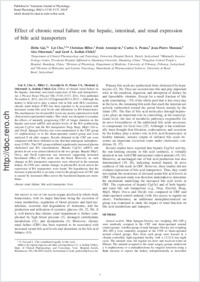Effect of chronic renal failure on the hepatic, intestinal, and renal expression of bile acid transporters
- Gai, Zhibo Department of Clinical Pharmacology and Toxicology, University Hospital Zurich, Switzerland
- Chu, Lei Minimally Invasive Urology Center, Provincial Hospital Affiliated to Shandong University, Jinan, Shandong, China
- Hiller, Christian Department of Clinical Pharmacology and Toxicology, University Hospital Zurich, Switzerland
- Arsenijevic, Denis Department of Medicine, Division of Physiology, University of Fribourg, Switzerland
- Penno, Carlos A. Division of Molecular and Systems Toxicology, Department of Pharmaceutical Sciences, University of Basel, Switzerland
- Montani, Jean-Pierre Department of Medicine, Division of Physiology, University of Fribourg, Switzerland
- Odermatt, Alex Division of Molecular and Systems Toxicology, Department of Pharmaceutical Sciences, University of Basel, Switzerland
- Kullak-Ublic, Gerd A. Department of Clinical Pharmacology and Toxicology, University Hospital Zurich, Switzerland
-
01.01.2014
Published in:
- American Journal of Physiology - Renal Physiology. - 2014, vol. 306, no. 1, p. F130–F137
English
Although the kidney is believed to play a minor role in bile acid (BA) excretion, chronic renal failure (CRF) has been reported to be associated with increased serum bile acid levels and alterations in BA homeostasis. The mechanisms for elevated BA levels are poorly understood in both clinical and experimental studies. This study was designed to examine the effects of naturally progressing CRF of longer duration on the hepatic and renal mRNA and protein levels of the BA synthesizing enzyme, Cyp7a1 and the BA transporters, Ntcp, Bsep, Mrp3, Ost-α and Ost-β. Sprague Dawley rats were randomized to the CRF group (5/6 nephrectomy) or to the sham-operated control group and were analyzed 8 weeks after surgery. Results obtained in the CRF rats were compared to those obtained in rats that had undergone uninephrectomy (UNX). The CRF group exhibited significantly increased plasma cholesterol and BA concentrations. Hepatic Cyp7a1 mRNA and protein levels were almost identical in the two groups. Hepatic Mrp3, Ost-α and Ost-β expression was increased, suggesting increased basolateral efflux of bile acids into blood. However, no such changes in BA transporter expression were observed in the remnant kidney. In UNX rats similar changes in plasma BA levels and in the expression of BA transporters were found. We hypothesize that the increase in plasma bile acids is an early event in the progression of CRF and is caused by increased efflux across the basolateral hepatocyte membrane.
- Faculty
- Faculté des sciences et de médecine
- Department
- Département de Médecine
- Language
-
- English
- Classification
- Biological sciences
- License
-
License undefined
- Identifiers
-
- RERO DOC 210114
- DOI 10.1152/ajprenal.00114.2013
- Persistent URL
- https://folia.unifr.ch/unifr/documents/303720
Statistics
Document views: 113
File downloads:
- pdf: 201
